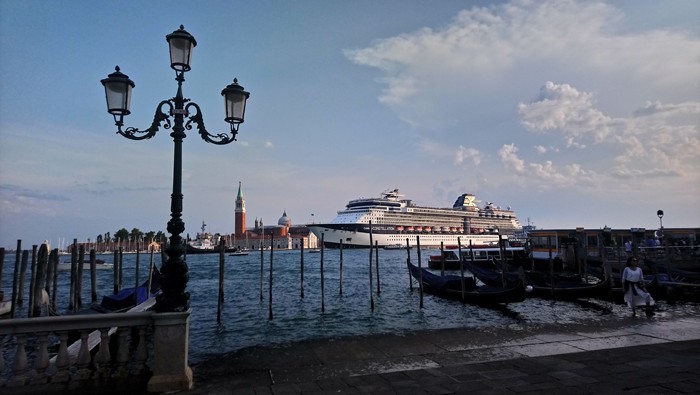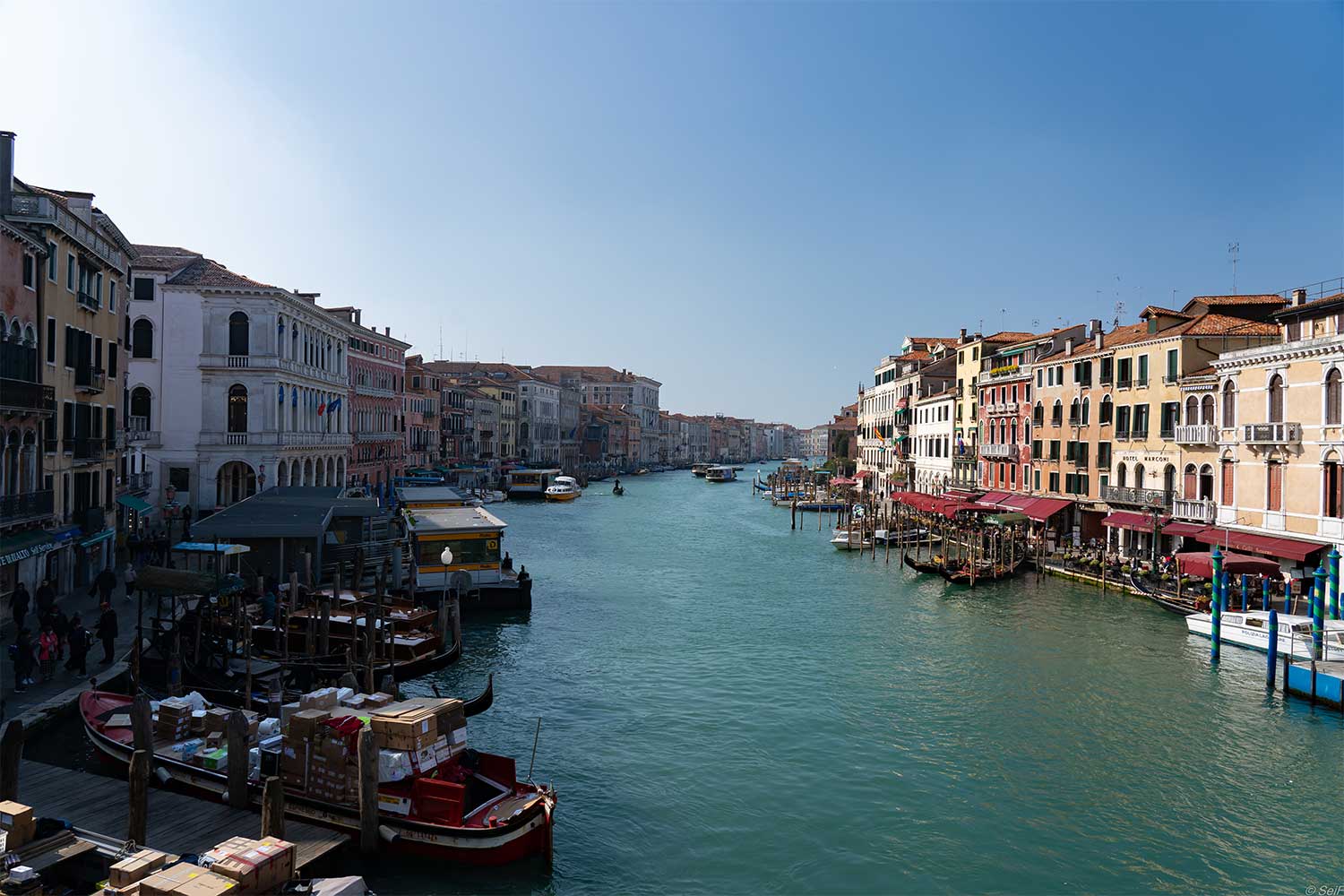Covid-19 is a Chance to Rethink Venice
Venetians call for a more sustainable city post-lockdown.
Venice’s Grand Canal on February 26, 2020, the day after Carnival festivities were wrapped up early due to the Covid-19 pandemic.
The Grand Canal in Venice — normally heaving with water-buses, service boats, gondolas, and water taxis — is calm. In a few areas of the city, once-murky canals have cleared enough to reveal shoals of fish and scuttling crabs in their depths. The extraordinary change has come as a result of the coronavirus lockdown, which has halted cruise ships from docking in the port, suspended or reduced vaporetto (water-bus) services, and cut the number of taxis and other motorboats traveling the canals.
Before the pandemic, Venetians dealt with high levels of air pollution — from motorboats with unregulated, outdated engines, and cruise ships whose fuel can contain up to 3,500 times as much sulfur as the diesel used in road vehicles.
Under lockdown — which started late February — these emissions have been slashed. European Space Agency satellites that record emissions from cars, cruise ships, and industrial activities have shown remarkable reductions in air pollution in northern Italy since the beginning of the coronavirus outbreak.
Proposed changes could see a greener, healthier, and more livable city that prioritizes people over vehicles and functions in harmony with its environment.
Now some residents — inspired by the environmental improvements — are pushing for long-term changes that could see Venice become more sustainable and reduce the negative impacts of tourism. Building on its completely pedestrianized centre, the proposed changes could see a greener, healthier, and more livable city that prioritizes people over vehicles and functions in harmony with its unique lagoon environment.
Matteo Secchi is president of the activist group Venessia, a pro-resident collective campaigning to improve quality of life in the city. The group has been particularly vocal about the damaging effects of big cruise ships and tourism in Venice, and hopes this period without international tourism may spark a change. The historic city centre — which has a dwindling population of about 52,000 — attracted 6 million tourists last year. Cruise ships can bring as many as 32,000 day-trippers to the city on some days, a type of tourism that has little economic benefit for local businesses. Big ships also create waves that damage the foundations of the city.
Another resident, Diana Vandeville, has instigated a petition pushing for measures to protect the environment and make Venice more livable. Now working as a translator, she moved to Venice a few years ago. “When I arrived in the city before the coronavirus crisis, I could see it was too exploited,” she says. “Now, in this historical moment, something can be done.”
Vandeville has collaborated with the residents’ rights organization Gruppo 25 Aprile to promote her petition, which has over 3,000 signatures. It calls for recognition of the harmful effects of motorized watercraft on the city, including exhaust fumes and erosive waves.
Before the stilling effects of lockdown, the Venetian lagoon was a “motorway of the sea,” says Vandeville, referring both to the number of boats passing through and their elevated speed. “I could smell the pollution as I walked through the city,” she says, “and I asked myself, ‘How can this be in a city with no cars?’”
I could smell the pollution, and I asked myself, “How can this be in a city with no cars?”
Vandeville explains that, in addition to exhaust fumes, motorboats cause moto ondoso or “wake pollution.” Wake pollution is the creation of artificial waves by boat movement, and in the shallow and narrow canals of Venice, this can erode building foundations. Wake pollution also disturbs canal floors, agitating the mud and sediment so water becomes murky. The waters are clearer now as these particles sink back down. “Wake pollution exacerbates the effects of high tide, damaging the built fabric of the city,” explains Vandeville.
In fact, erosion from wake pollution has the “destructive potential to sink the city,” according to research from Worcester Polytechnic Institute that studied the impacts of boat traffic.
There are repercussions on the natural environment of the lagoon, too. The waves unsettle the seabed, disturbing and destroying its characteristic sandbanks. The lagoon sandbanks are home to a delicate ecosystem of plant life and various mollusks and crustaceans. The faster boats travel, the greater the agitation of the seafloor and the greater the destruction of this habitat.
Vandeville also points out that motorized craft prevent traditional rowing boats from using the canals because of safety concerns. The mix of large and small boats — as well as lax rules on operating watercraft while intoxicated or using a mobile phone — has caused accidents in the past, including the death of a German tourist in a gondola that was crushed by a water-bus. In 2018, the City Council decided to ban recreational boats like kayaks and canoes from the city’s main waterways.
Vandeville’s petition proposes introducing a stricter system to ensure motorized craft stay within speed limits. “Speeding causes greater air pollution, it damages the lagoon ecosystem, and it’s dangerous for people in smaller boats,“ says Vandeville. She explains that there is already a system in place to monitor speed, but it’s not used effectively.
Public water-buses are running on biofuel made from recycled cooking oil.
The petition also pushes for boats to be refitted with eco-friendly hybrid or electric engines, and to use less-polluting fuel. “One good thing that is already happening is that public water-buses are running on biofuel made from recycled cooking oil,” says Vandeville. “This should be increased.” The Italian oil and gas company Eni has been converting cooking oil from the city’s restaurants into biofuel. Instead of being discarded into the lagoon, where it can damage flora and fauna, the oil powers the city’s transport system.
Venice and its lagoon live in symbiosis, as the city relies on the sea for transport and local industries like fishing, but is also vulnerable to damaging waves and rising water levels. With greener engines and stricter speed controls for boats, Venice could have clean air, quieter canals, less damage to buildings, and a healthier ecosystem, becoming a model of a city living in harmony with its natural environment. Few other major cities have the potential to create an urban environment that prioritizes pedestrians so highly.

A cruise ship towers over smaller craft in the Venice Lagoon.
Vandeville’s petition also touches on another big polluter: tourism. Visitors to the city leave a huge amount of waste behind. As the Guardian reported last year, “during high season the bins around Piazza San Marco have to be emptied every half an hour.”
In addition, boat traffic from tourism accounts for almost half the wake pollution, while big cruise ships emit noxious gases like sulfur and nitrogen dioxide, a major cause of the surprisingly high levels of air pollution in a carless city. In 2019, Venice’s average air quality was worse than Milan’s in the industrial heartlands of Lombardy.
“I am not against tourism,” Vandeville explains, “but I’m against a kind of tourism that is destroying the city.” The overwhelming number of tourists flocking to Venice has meant Airbnb properties have tripled since 2015, bumping up rent prices and pushing more residents to move to the mainland where house prices are lower. Amenities for locals disappear while souvenir shops multiply, and employment opportunities are limited and centred around tourism.
Monica Cesarato runs food tours and cooking classes in Venice, and is eager to see a change. Sustainable tourism, she explains, is when “tourists become visitors, and they experience the city profoundly, not superficially.” She emphasizes, “visitors don’t need to be rich, but they need to invest money in the right places: local businesses, museums, artisans.”
The biggest mistake of Venetians was to make our economy a monoculture of tourism.
The World Tourism Organization also asserts that tourism should “conserve natural heritage and biodiversity” and ensure “stable employment and income-earning opportunities.”
For years, over-tourism has provoked protests by Venetians, especially as the industry has become almost the sole source of revenue the city. “The biggest mistake of Venetians was to make our economy a monoculture of tourism, and now we are in big trouble,” explains Secchi, the Venessia president.
Ten years ago, Venessia proposed a political program that pushed for more varied forms of income for the city, including relaunching artisan activities and historic industries like boatbuilding. “Venice was the most famous in the world for making boats. Now, we get our water-buses from Naples,” he says.
As an alternative to today’s mordi e fuggi (“hit and run”) daytripper tourism, Vandeville suggests boosting both historic artisan activities — including glass- and lace-making, which already have an international market — alongside newer options, such as cooking projects exploring the rich lagoon cuisine. These could stimulate much-needed redevelopment in run-down areas of the city where new workshops could be created, and, in Cesarato’s words, “connect visitors more deeply with the city through interaction with residents and authentic activities.”
Secchi has a more radical idea. He wants Venice to entice industries focused on non-material production that would generate less boat traffic than tourism does. “Yahoo, Google, and other software companies can come to Venice,” he suggests, “and build their offices instead of hotels.”
Cesarato agrees: “There are so many empty buildings: turn them into IT and service companies.” Moving from dependence on tourism to more diverse forms of revenue means creating a city that is more livable for its residents and offers better job prospects with steadier incomes.
She explains, “there will be more residents in the city, which means more local shops, and so on, reversing the vicious circle.” The city could exemplify a form of sustainable tourism that is beneficial, rather than detrimental, to its residents. “The community will thrive again,” Cesarato says.
The city could exemplify a form of sustainable tourism that is beneficial to its residents.
The biggest problem that these sustainability campaigns face is time. While speed cameras for boat traffic are in place and biofuel is already being produced and trialed in Venice, altering the economy is a process that “could take over 20 years,” says Secchi.
As such, he acknowledges that, for the foreseeable future, tourism will still be necessary. However, he’s adamant that the number of visitors must be strictly controlled. “We have to be smart and not make the old mistakes,” says Secchi. “Tourists can’t come all at once.”
Although the challenges are great, Vandeville believes people in Venice agree with what her petition proposes. “They want to see change,” she says.
Correction: This article originally included a widely referenced claim that cruise ships can bring up to 44,000 day-trippers to Venice on some days. The original source of that number is unclear, so it’s been updated to a number recently obtained by CNN from the Venice Port Authority: 32,000.
